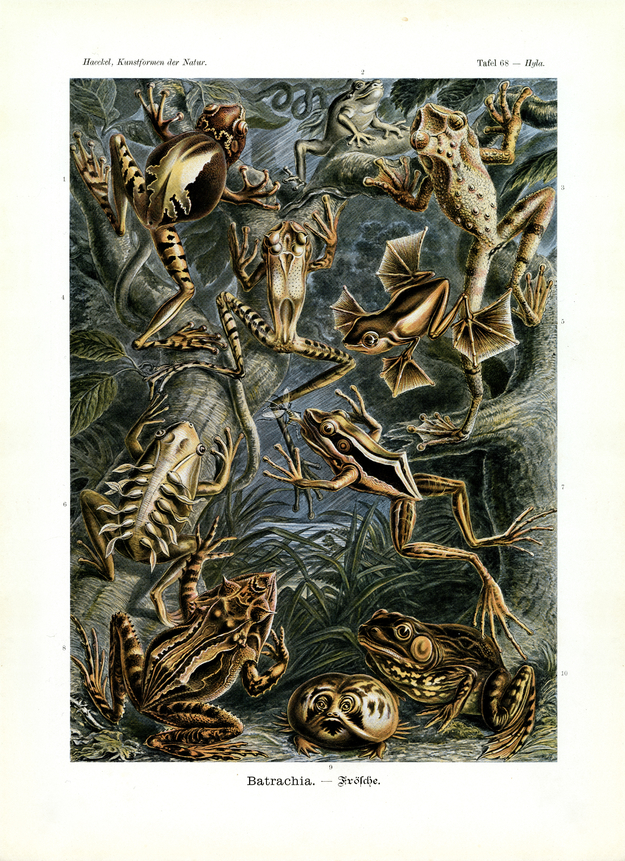Translation of the original German introduction by Ernst Haeckel:
Phylum of Vertebrata (Wirbeltiere); - main class of Gnathostoma (Kiefermäuler); - class of Amphibia (Lurche); - subclass of Lissamphibia (Nacktlurche); - legion of Batrachia (Frösche) or Anura, Ecaudata (schwanzlose Amphibien); - order of Ranacea (Erdfrösche) and Hylacea (Laubfrösche).
The legion of frogs or the modern group of Anura (acaudal amphibian) is usually contrasted to the older, caudate amphibians (Salamander and relatives, Urodela; the former have developed out of the latter by regression of the tail and a stronger formation of both pairs of legs. In true frogs especially the hint legs are predominantly developed through adaptation into powerful ‘leaping organs’.
The organism of frogs appears highly developed compared to other amphibians, but remains of a medial development stage in relation to other vertebrates. All amphibians are vertebrates of medial range; they are decisively higher developed than fishes from which they originate, but they are located below their epigoni, the reptiles. It is with the amphibians that, during the ‘coal period’, for the first time the organism of terrestrial vertebrates occurs, having four five-toed feet (Pentadectylia or Tetrapoda); all the older vertebrates of the previous Devonian Age have been aquatic fishes with multi-radial fins (Pinnata). The older, caudated amphibians, the still living ‘gilled amphibians’ (Perennibranchia) possess throughout their lives gills apart from the lungs; they can breathe interchangeably, in water with the help of gills and on land with the lungs.
Until today frogs annually repeat the history of the phylum in their individual germ development; according to the biogenetic basic principle the frogs’ history of germ development (Ontogeny) appears like a densely packed extract of the history of their phylum (Phylogeny). From the eggs of frogs that most species deposit in spring as “spawn” into the water the well-known caudate tadpoles (Gyrini) develop; in the beginning they have no legs but swim friskily in the water with the help of their lancet-shaped, transparent ‘rudder-tail’; they do not possess lungs as well, rather breathe at first with the help of exterior, later interior gills. The overall body structure of the tadpole resembles fishes, not the grown frogs into which they transform within a few weeks. The processes of metamorphosis are highly instructive and provide irrefutable evidence for the basic principle of biogenetics as well as the theory of evolution based on it. Among the amphibians of the ‘hot zones’ are many species that have shortened or even forfeit the original (palingenetic) process of germ development, assuming an altered (cenogenetic) form of it. This is usually linked with a peculiar form of parental care with mother and father participating individually or together. Some frogs (especially species from South America) carry their one ones for a while on their backs, either freely (fig. 6) or concealed in a sac or pouch (fig. 1).
Translation by VR Translators Bangalore
We've scanned the original lithography at 1200dpi on the Epson A3 scanner of A3 scanner huren. You can download a 400dpi JPEG here.
